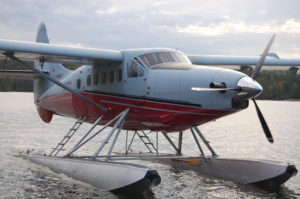 Introduction:
Introduction:
So you’re going on a fishing trip – good for you! Planning the trip is part of the fun, and if done well, you’ll spend more time enjoying yourself, and less time lamenting those “I can’t believe I forgot to pack…” moments. I’ve built this list over years of both drive-to and remote fly-in trips, and I modify it every year.
Considerations:
Your requirements can vary wildly depending on if you are going to a full service, American Plan drive-to lodge for a weekend versus a remote fly-in location where you supply all your own equipment and have a weight restriction as well. This list is built for the latter in mind, so you may be able to cross some things off the list if the lodge already provides it. Keep in mind you often have between 75 lbs and 100 lbs per person for total gear weight (food, gear, equipment etc)
On some trips, I have taken enough clothes for ½ the week, and then taken soap to do laundry on site. It’s amazing how much room that small step can save.
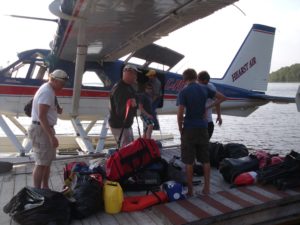 Personal:
Personal:
Socks: Consider multi-layer socks that wick moisture, like you would use for hiking.
Underwear:
Shorts: If the season suggests.
Pants: Jeans can be heavy and soak up the water, I prefer hiking style pants that are light, wick water, and dry quickly.
Swimsuit: I’ve never gone swimming on a fishing trip but some are known to. Also, if you are showering in the lake, this could help with modesty.
T-Shirt (s): Enough for the week, consider SPF and wicking shirts.
Sweater: Something for the cool mornings / evenings, or for sitting around the fire.
Jacket: I prefer a light shell that I can layer a sweater under. If your shell is Gortex you have your rain-gear half done.
Gloves: I bring warmer gloves in case of snow, then a wind resistant pair for those cool, wet days. You may want to consider fish handling gloves too, as a small cut in the wild can become a problem in a hurry.
Hats: You may not be used to many days in the boat, and even in cool weather that sun can take a toll. Consider wide brimmed hats that will protect your face and neck.
Footwear: I take some sandals to wear around camp, and a pair of Gortex hikers for all other times.
Rain Gear: This can make or break your trip, so be sure to bring quality rain gear. For the investment in the trip, you don’t want to miss whole days of fishing because you didn’t bring good gear.
Thermal Underwear: It packs small and can be a lifesaver for cool evenings, while sleeping, or if you get unexpectedly cold weather.
Buff: Great for protecting from wind, sun, and the bugs!
Toiletries: Toothbrush, soap, floss, deodorant
Lip Balm: Be sure it has SPF, and remember to wear it on a windy day.
Sunscreen: I’ve known guys who had to be flown out of a trip early because of sunburn, so be sure to bring a high SPF and wear it.
Fishing License: Even on the most remote trips you can expect the ministry to visit.
Boaters Card: See above.
Medications: This would include prescription, but also things like vitamins, tums etc.
Sunglasses: Polarized are best, and bring a spare in case yours break / fall overboard.
Camera: Bring extra batteries, and if you have a storage card, bring a spare.
Insect repellent: The stronger the better.
Flashlight: Small but powerful.
Lighter: This will come in handy over and over.
Towel for shower: Consider microfiber, they are super small / light and highly absorbent.
PFD: At most outposts you must provide your own. Don’t be proud, wear it and stay alive.
Water Bottle. It’s amazing how little liquid we drink on trips; bring a water bottle and try to finish one each day. For outposts, bring some flavor crystals to counter the taste.
Book / Magazine: When the weather is inclement, or you just want some down time, a book on the deck / dock can be just the ticket.
Sleeping bag: Appropriate for expected temperatures, and packed tight.
Pillow: I take a blow-up pillow to save space, but it still allows me a good night’s sleep.
Sheet: I put a flat sheet on the mattress and use my sleeping bag as a blanket on those milder nights.
Facecloth: Keep clean!
Power! If you are staying at a location with no, or limited power, be sure to bring some portable power packs so you’re not left without options
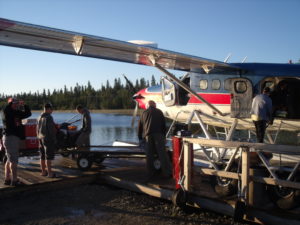 Group Items
Group Items
Garbage Bags: I often put our boxes in garbage bags to keep them dry as we travel, but have a supply for both camp waste and water penetration.
Paper Towels: Just plain handy.
Toilet Paper: Don’t count on the group before you leaving any, and if you were to bring an extra roll, no one would complain.
Kleenex: You are bound to need a couple of boxes.
Dish Cloth: A clean camp is much more enjoyable.
Soap: I use a camp soap for both dishes and personal clean up.
Dish Towels: Usually you don’t have a drying rack or much counter space.
Oven Mitts: Good for both getting food out of the oven, and also for working the shore lunch.
String / Twine with Clothespin: I use these to make a clothes line to dry belongings, tie down a tarp, etc.
Zip Lock Bags: For fish filets, or for leftovers.
Ice: If you can have the lodge fly some in with you, it helps manage fridge space (which is usually at a premium) by using coolers.
Foil Trays: For re-heating foods, or working at the shore lunch.
Water containers: I take a 5-gallon container, fill it with lake water, and then treat it. Usually 3-4 gets us through the week, and we don’t use up our scarce weight allowance by bringing in bottled water.
Ice Cube Trays: If you don’t bring in ice, at least you can make your own!
Antibacterial Soap: For in the kitchen or in the bathroom, keep the hands clean as you will get countless nicks that can become infected.
Can Opener: Because even if there is one at the camp, it likely doesn’t work.
Shower Bag: If you don’t have running water, and don’t want to dip in the lake, a shower bag hanging from a tree can be a great compromise.
Duct Tape: Whether it’s to fix something, or to wrap an injury, duct tape is awesome.
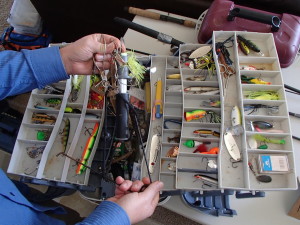 Fishing Gear
Fishing Gear
Nets: I bring a dip net and cradle net per boat
Tackle box: I use a soft case with trays to save space because the boats are usually smaller than what I’m used to at home.
Sonar: We bring a portable fish finder, per boat and a spare battery if no power is available to recharge. Most often you can get the week out of a battery once you know the lake.
Multi Tool: It’s amazing how many times you need the screw driver, or pliers, or saw…
Knife: I bring a solid knife, as well as a fillet knife, and a Swiss army knife.
Fishing Rods: Personal preference, but bring at least two, and have a couple spares for the group. If you are flying in, a carrying case and two-piece rods are helpful.
Reels: Bring at least one spare of each type in case one gets damaged.
Line: Have your reels pre-loaded, but bring some spare line in case a bird’s nest gets the better of you, or you run over your line, or a fish runs you out…you get it.
Stringer: I hope you are planning to eat some of your catch where permitted.
Pliers: Sometimes the hook needs some help coming out.
Spreaders: Hungry fish take it deep some times, and other times they just don’t want to say “awww”.
Gas treatment: I find out if the motor are two or four stroke and bring a can of gas treatment just as a pick-me-up for what are normally serviceable, but heavily used motors.
Marker Buoys: When you get to a new lake, it’s a great idea to have some marker buoys with you to identify the key drop offs and weed edges so you have quick reference points. It will help save your battery on your fish finders as well.
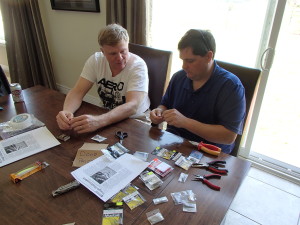 Tackle (Depending on your species of course)
Tackle (Depending on your species of course)
First, take a hard look at your gear, and take only what you use regularly. If you are on a fly-in trip, the weight and space limitations require you to pare down what you bring. Talk to your group and share your gear so that you don’t all bring the same items. Bring a spare of your “go to” lures, if you are in the wild they can’t be replaced until after the trip. That being said, I bring…
Jigs: Various size and colours, and I plan to share.
Soft plastics: Normally some grubs for the jigs, crawlers, and swim baits.
Swim Bait hooks: Various sizes, depending on your plastics and your targets.
Spoons: I like Williams Wabblers, Johnshon Silver Minnor and Dr. Spoons.
Crank baits: I like to mix up the size and colours with the group.
Body Baits: For Pike, the bigger sometimes the better!
Worm Harness: I bring a few pre-made, and the others I make as needed.
Top Water Lures: If you like this action, you know what you’ll need!
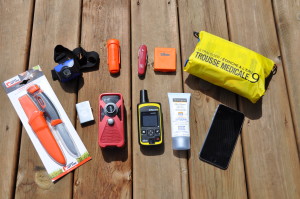 Safety:
Safety:
First Aid Kit: Well-stocked, including some anti bacterial cream such as polysporin.
Flint and Fire Starter: You never know when you’ll need to start a fire to cook from, to keep you warm, or to light a signal.
Satellite Device: In case of a real emergency, likely medical, being able to communicate with First Responders is essential. I use a two-way communication device called the InReach Explorer.
Radio: I take cranking radio with me, and can usually pick up emergency weather stations at the least.
Water Treatment: If you are counting on the lake water, even in the remotest part of the land, some form of treatment stysem is a must.
Compass: When you are on a new body of water, or if you need to hike out for some reason, knowing your direction can make all the difference.
Extra Food: If you are expecting to be flown out, it doesn’t take much in the way of a weather change to ground a floatplane. Have at least one extra day’s rations with you.
Hope you enjoyed the list! As always don’t forget, to sign up and have my most recent post sent right to you! Care to add to the list, email me at scott@canadianfisherman.ca